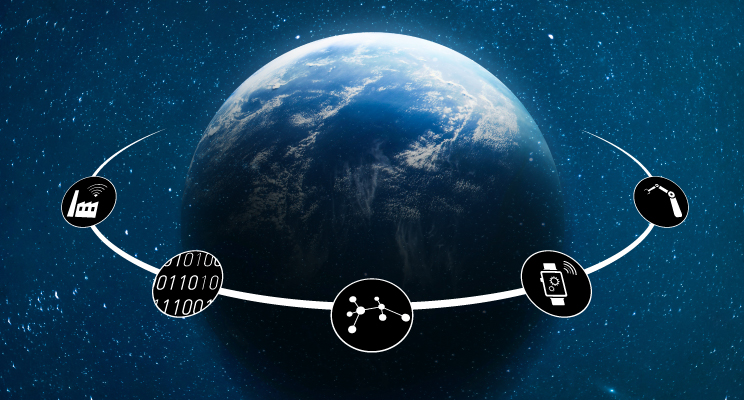
Why do some regions thrive economically and others not? In this article, SATW member Georges Kotrotsios takes a close look at some key competition factors for industrial ecosystems and warns about global imbalances if risks and benefits are unequally shared between the private and public sector.
Economic ecosystems flourish within specific geographic areas and produce jobs and value. Their dominance over competing ecosystems can create more jobs and more well-being for the communities in the corresponding geographical area. Dominance can, however, shift from one ecosystem to another, meaning from one area to another. And this can happen with increasing rapidity. Who could have imagined 30 years ago that the fishing village of Shenzhen would become a world-beater in the electronics sector? Or foreseen the transformation of South Korea from a quasi-bankrupt state with an impoverished population in the 1960s to today’s flourishing economy? This is due both to unprecedented mobility—including that of people and, much more significantly, that of capital—and, above all, to digitalization, which accelerates competition and leverages competitiveness, and where technological evolution plays an increasingly important role in the success or failure of ecosystems. In this context one can see three important factors that shape ecosystems’ quest for dominance: tradition, public incentives and entrepreneurship, and a large addressable market.
Regarding industrial tradition, an illustrative example is the pharma industry. Pharma is a legacy of the chemical industry. The chemical industry itself is a legacy of the textile industry. Europe’s textile industry began at the time of the Renaissance. All these industries are still alive today, and operating in the same or relatively nearby areas; pharma in particular is flourishing in Basel (Switzerland), Germany, and France. But tradition is not enough to maintain a comparative advantage. Public incentives and/or significant private investment enable the creation of new ecosystems. Highly illustrative of this fact are the creation—almost ex nihilo—of a civil aeronautics industry in Europe or the microelectronics industry in Taiwan and South Korea. Large—initial—addressable markets enable new business to start up faster: culture (the ways in which buyers think), regulations, and legal constraints are quite uniform, while cross-border challenges are avoided. The best and most illustrative example here is the fast growth of the Internet industry and its Big Data dominant technology companies: the GAFAs in the USA or BATX in China. In Europe, Industry 4.0 was an explicit effort to repatriate manufacturing (and related engineering as well as R&D jobs). It succeeded in increasing the productivity of individual industrial units. However, it failed to bring a specific comparative advantage to Europe, as had been initially hoped, since it spilled over rapidly (and naturally) to the rest of the world, similar incentives being applied globally.

Ecosystems can be based on technology platforms (e.g., social media, digital technology, or big data-based artificial intelligence) or on markets/applications (e.g., automotive, textiles, microelectronics). The latter have as their foundation a more or less long industrial tradition. Technology platform ecosystems by their very nature tend to operate in a quasi-monopolistic, “winner takes all” manner, creating a kind of “technology oligarchy”. Application- or market-oriented ecosystems can be more diverse in geographical terms and therefore allow for a more homogeneous distribution of wealth. An illustrative example of the struggle between technology platform ecosystems and specific market-/application-oriented ecosystems is the watchmaking industry. Watchmaking is deeply rooted in Europe, in particular in western Switzerland since the sixteenth century. Today, the smartwatch— created in less than half a decade—generates for Apple practically one-third of the revenues of the entire Swiss watch industry.
Is it possible to influence the race for dominance of one or other path? Private entrepreneurship can be cultivated, and above all supported, by fair and sustaining policies, including by public incentives (financial, regulatory, educational, or environmental). To be able to offer these incentives, the public domain requires robust finances. This can mean, among other things, the fair return of a portion of the financial gains of the private sector generated by risk taken by the public sector, to the public sector; meaning, in turn, that the public domain does not suffer unduly from the risk taking of private entrepreneurship. The roles of the public domain and the private domain are changing rapidly. Strength, flexibility, and leadership in the public domain are key enablers for the empowerment of healthy private entrepreneurship and the leveraging of industrial tradition. But these characteristics can only be sustained if built upon the foundations of a fair return of a portion of the gains of the private domain to the public domain, and of balanced risk taking. If we lack these qualities, we will be driving the dominance of technological platform-based clusters, and in the process will bring about a kind of cluster “oligarchy” that will, itself, drive global imbalances.
Dr. Georges Kotrotsios, georges.kotrotsios(at)csem.ch
SATW member Georges Kotrotsios is Vice President Marketing and Business Development, Member of Executive Board of the Swiss Centre for Electronics and Microtechnology (CSEM). CSEM is a private, non-profit Swiss research and technology organization focused on generating value for a sustainable world. Georges Kotrotsios studied electrical engineering at Aristotle University in Thessaloniki and at the Institut polytechnique de Grenoble, where he obtained a Ph.D. in optoelectronics. Furthermore, he holds an MBA in technology management from the University of Lausanne.
